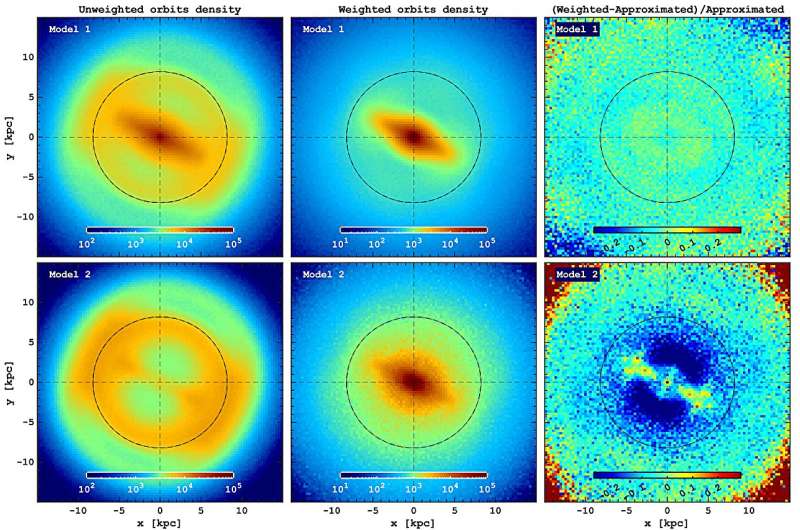
December 19, 2024 by Janine Fohlmeister, Leibniz Institute for Astrophysics Potsdam
Collected at: https://phys.org/news/2024-12-unveiling-uncharted-milky-galactic-stellar.html
By peering into the cosmic dance of stars, a team led by researchers from the Leibniz Institute for Astrophysics Potsdam (AIP) has unraveled the complex structure of our Milky Way galaxy. Assuming that each observed star represents a larger population of stars sharing the same orbit, they have reconstructed the properties of these “hidden” stars, filling in gaps in the galactic disk that holds the secrets of our galaxy’s past, present, and future.
Our understanding of the galaxy has advanced with every leap in the number of stars. From early observations to more and more advanced space and ground-based telescopes, each milestone has revealed new layers of the galaxy’s complex structure and motion. While stellar surveys continue to expand in volume, our view of the Milky Way remains severely obscured, with the vast majority of stars we can study concentrated around the sun.
This discrepancy is largely due to a fundamental limitation of our observations, originating from our position in the central plane of the Milky Way’s disk. Our location limits the volume of potentially observable stars, depending on how bright they appear, which is further affected by dust and gas that can block or dim their light, called interstellar medium extinction.
Researchers at the Leibniz Institute for Astrophysics Potsdam (AIP), in collaboration with the University of Vienna and the Paris Observatory, have developed an innovative method to fill the gaps in our understanding of the structure of the Milky Way. They have shown that instead of relying solely on observations of individual stars, the entire orbits of real stars can be used to represent the structure and dynamics of the galaxy.
As stars move around the galactic center, they serve as a tool for mapping regions of the galaxy that are beyond the direct reach of our telescopes, including areas on the other side of the Milky Way. Using a model for the Milky Way’s mass distribution and the observed positions and velocities of stars, they not only calculated the orbits of stars but, more importantly, measured how much mass should be associated with each orbit.
Using a novel technique applied to a large sample of stars with spectroscopic parameters from the APOGEE survey, which is part of the Sloan Digital Sky Survey, the researchers have mapped stellar kinematics across the Milky Way. For the first time, they have revealed the intricate motion of stars in the bar region without being hindered by uncertainties in distance measurements.
By reconstructing stellar orbits using real Milky Way stars with accurately determined parameters, the team quantified the galaxy’s mass-weighted chemical abundances and age structure. This approach bypasses the challenges posed by the dense inner regions and interstellar medium extinction, delivering a comprehensive view of stellar populations, including previously unobservable areas on the far side of the Milky Way galaxy.
The study has been posted to the arXiv preprint server as a series of three papers.
Sergey Khoperskov, scientist at AIP and first author of the studies, explains, “We can look at this approach from a different perspective. Imagine that for every star we observe, there is a large sample of stars that follow exactly the same orbit but, for various reasons, weren’t captured by the survey. What we are doing is reconstructing the positions, velocities and stellar parameters of these invisible stars, filling in the missing pieces of the galaxy’s structure.”
The new data strongly suggest that the Milky Way galaxy was formed in two distinct phases, manifested by different age-chemical abundance relations. The inner disk, located well within the radius of the sun, formed relatively quickly during the early stages of the galaxy’s evolution. About 6–7 billion years ago, the outer disk began to assemble, rapidly expanding the radial extent of the Milky Way and shaping its present structure.
More information: Sergey Khoperskov et al, Rediscovering the Milky Way with orbit superposition approach and APOGEE data I. Method validation, arXiv (2024). DOI: 10.48550/arxiv.2411.15062
Sergey Khoperskov et al, Rediscovering the Milky Way with orbit superposition approach and APOGEE data II. Chrono-chemo-kinematics of the disc, arXiv (2024). DOI: 10.48550/arxiv.2411.16866
Sergey Khoperskov et al, Rediscovering the Milky Way with orbit superposition approach and APOGEE data III. Panoramic view of the bulge, arXiv (2024). DOI: 10.48550/arxiv.2411.18182
Journal information: arXiv

Leave a Reply